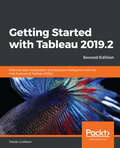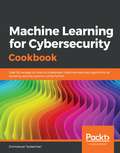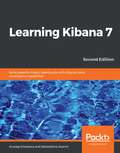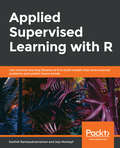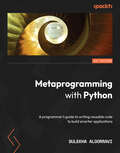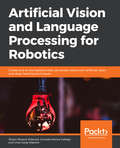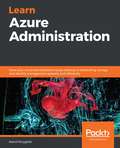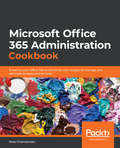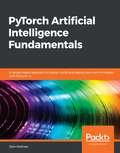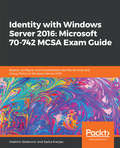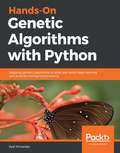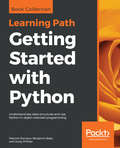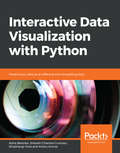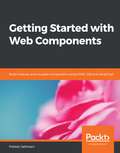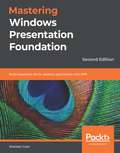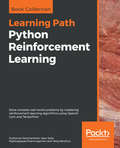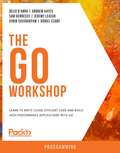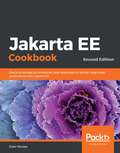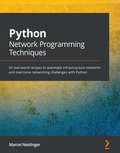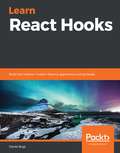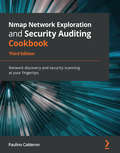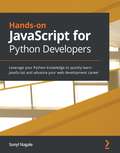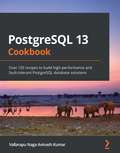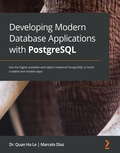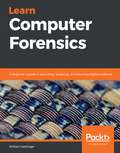- Table View
- List View
Getting Started with Tableau 2019.2: Effective data visualization and business intelligence with the new features of Tableau 2019.2, 2nd Edition
by Tristan GuillevinLeverage the power of Tableau 2019.1’s new features to create impactful data visualizationKey FeaturesGet up and running with the newly released features of Tableau 2019.1Create enterprise-grade dashboard and reports to communicate your insights effectivelyBegin your Tableau journey by understanding its core functionalitiesBook DescriptionTableau is one of the leading data visualization tools and is regularly updated with new functionalities and features. The latest release, Tableau 2019.1, promises new and advanced features related to visual analytics, reporting, dashboarding, and a host of other data visualization aspects. Getting Started with Tableau 2019.1 will get you up to speed with these additional functionalities.The book starts by highlighting the new functionalities of Tableau 2019.1, providing concrete examples of how to use them. However, if you're new to Tableau, don’t worry – you’ll be guided through the major aspects of Tableau with relevant examples. You'll learn how to connect to data, build a data source, visualize your data, build a dashboard, and even share data online. In the concluding chapters, you'll delve into advanced techniques such as creating a cross-database join and data blending.By the end of this book, you will be able to use Tableau effectively to create quick, cost-effective, and business-efficient Business Intelligence (BI) solutions.What you will learnDiscover new functionalities such as ‘Ask Data’, the new way to interact with your data using natural languageConnect tables and make transformations such as pivoting the field and splitting columnsBuild an efficient data source for analysisDesign insightful data visualization using different mark types and propertiesDevelop powerful dashboards and stories Share your work and interact with Tableau ServerUse Tableau to explore your data and find new insightsExplore Tableau's advanced features and gear up for upcoming challengesWho this book is forExisting Tableau users and BI professionals who want to get up to speed with what's new in Tableau 2019 will find this beginner-level book to be a very useful resource. Some experience of Tableau is assumed, however, the book also features introductory concepts, which even beginners can take advantage of.
Machine Learning for Cybersecurity Cookbook: Over 80 recipes on how to implement machine learning algorithms for building security systems using Python
by Emmanuel TsukermanLearn how to apply modern AI to create powerful cybersecurity solutions for malware, pentesting, social engineering, data privacy, and intrusion detection Key Features Manage data of varying complexity to protect your system using the Python ecosystem Apply ML to pentesting, malware, data privacy, intrusion detection system(IDS) and social engineering Automate your daily workflow by addressing various security challenges using the recipes covered in the book Book Description Organizations today face a major threat in terms of cybersecurity, from malicious URLs to credential reuse, and having robust security systems can make all the difference. With this book, you'll learn how to use Python libraries such as TensorFlow and scikit-learn to implement the latest artificial intelligence (AI) techniques and handle challenges faced by cybersecurity researchers. You'll begin by exploring various machine learning (ML) techniques and tips for setting up a secure lab environment. Next, you'll implement key ML algorithms such as clustering, gradient boosting, random forest, and XGBoost. The book will guide you through constructing classifiers and features for malware, which you'll train and test on real samples. As you progress, you'll build self-learning, reliant systems to handle cybersecurity tasks such as identifying malicious URLs, spam email detection, intrusion detection, network protection, and tracking user and process behavior. Later, you'll apply generative adversarial networks (GANs) and autoencoders to advanced security tasks. Finally, you'll delve into secure and private AI to protect the privacy rights of consumers using your ML models. By the end of this book, you'll have the skills you need to tackle real-world problems faced in the cybersecurity domain using a recipe-based approach. What you will learn Learn how to build malware classifiers to detect suspicious activities Apply ML to generate custom malware to pentest your security Use ML algorithms with complex datasets to implement cybersecurity concepts Create neural networks to identify fake videos and images Secure your organization from one of the most popular threats – insider threats Defend against zero-day threats by constructing an anomaly detection system Detect web vulnerabilities effectively by combining Metasploit and ML Understand how to train a model without exposing the training data Who this book is for This book is for cybersecurity professionals and security researchers who are looking to implement the latest machine learning techniques to boost computer security, and gain insights into securing an organization using red and blue team ML. This recipe-based book will also be useful for data scientists and machine learning developers who want to experiment with smart techniques in the cybersecurity domain. Working knowledge of Python programming and familiarity with cybersecurity fundamentals will help you get the most out of this book.
Learning Kibana 7: Build powerful Elastic dashboards with Kibana's data visualization capabilities, 2nd Edition
by Bahaaldine Azarmi Anurag SrivastavaA beginner's guide to analyzing and visualizing your Elasticsearch data using Kibana 7 and Timelion Key Features Gain a fundamental understanding of how Kibana operates within the Elastic Stack Explore your data with Elastic Graph and create rich dashboards in Kibana Learn scalable data visualization techniques in Kibana 7 Book Description Kibana is a window into the Elastic Stack, that enables the visual exploration and real-time analysis of your data in Elasticsearch. This book will help you understand the core concepts of the use of Kibana 7 for rich analytics and data visualization. If you're new to the tool or want to get to grips with the latest features introduced in Kibana 7, this book is the perfect beginner's guide. You'll learn how to set up and configure the Elastic Stack and understand where Kibana sits within the architecture. As you advance, you'll learn how to ingest data from different sources using Beats or Logstash into Elasticsearch, followed by exploring and visualizing data in Kibana. Whether working with time series data to create complex graphs using Timelion or embedding visualizations created in Kibana into your web applications, this book covers it all. It also covers topics that every Elastic developer needs to be aware of, such as installing and configuring Application Performance Monitoring (APM) servers and agents. Finally, you'll also learn how to create effective machine learning jobs in Kibana to find anomalies in your data. By the end of this book, you'll have a solid understanding of Kibana, and be able to create your own visual analytics solutions from scratch. What you will learn Explore the data-driven architecture of the Elastic Stack Install and set up Kibana 7 and other Elastic Stack components Use Beats and Logstash to get input from different data sources Create different visualizations using Kibana Build enterprise-grade Elastic dashboards from scratch Use Timelion to play with time series data Install and configure APM servers and APM agents Work with Dev Tools, Spaces, Graph, and other important tools Who this book is for If you're an aspiring Elastic developer or data analysts, this book is for you. You'll also find it useful if you want to get up to speed with the new features of Kibana 7 and perform data visualization on enterprise data. No prior knowledge of Kibana is expected, but some experience with Elasticsearch will be helpful.
Applied Supervised Learning with R: Use machine learning libraries of R to build models that solve business problems and predict future trends
by Jojo Moolayil Karthik RamasubramanianExplore supervised machine learning with R by studying popular real-world uses cases such as object detection in driverless cars, customer churn, and default predictionKey FeaturesStudy supervised learning algorithms by using real-world datasets Fine tune optimal parameters with hyperparameter optimizationSelect the best algorithm using the model evaluation frameworkBook DescriptionR provides excellent visualization features that are essential for exploring data before using it in automated learning. Applied Supervised Learning with R helps you cover the complete process of employing R to develop applications using supervised machine learning algorithms for your business needs. The book starts by helping you develop your analytical thinking to create a problem statement using business inputs and domain research. You will then learn different evaluation metrics that compare various algorithms, and later progress to using these metrics to select the best algorithm for your problem. After finalizing the algorithm you want to use, you will study the hyperparameter optimization technique to fine-tune your set of optimal parameters. To prevent you from overfitting your model, a dedicated section will even demonstrate how you can add various regularization terms.By the end of this book, you will have the advanced skills you need for modeling a supervised machine learning algorithm that precisely fulfills your business needs.What you will learnDevelop analytical thinking to precisely identify a business problemWrangle data with dplyr, tidyr, and reshape2Visualize data with ggplot2Validate your supervised machine learning model using k-fold Optimize hyperparameters with grid and random search, and Bayesian optimizationDeploy your model on Amazon Web Services (AWS) Lambda with plumberImprove your model’s performance with feature selection and dimensionality reductionWho this book is forThis book is specially designed for novice and intermediate-level data analysts, data scientists, and data engineers who want to explore different methods of supervised machine learning and its various use cases. Some background in statistics, probability, calculus, linear algebra, and programming will help you thoroughly understand and follow the content of this book.
Metaprogramming with Python: A programmer's guide to writing reusable code to build smarter applications
by Sulekha AloorRaviA practical approach to metaprogramming with real-world examples that enables the development of advanced frameworks, libraries, and applications using PythonKey FeaturesLearn applied metaprogramming through a simple step-by-step approachWork with easily understandable examples and explanations that take you deep into the theory of metaprogrammingGet practical experience in writing reusable code with real-world examplesBook DescriptionEffective and reusable code makes your application development process seamless and easily maintainable. With Python, you will have access to advanced metaprogramming features that you can use to build high-performing applications. The book starts by introducing you to the need and applications of metaprogramming, before navigating the fundamentals of object-oriented programming. Next, you will learn about simple decorators, work with metaclasses, and later focus on introspection and reflection. You'll also delve into generics and typing before defining templates for algorithms. As you progress, you will understand your code using abstract syntax trees and explore method resolution order. This Python book also shows you how to create your own dynamic objects before structuring the objects through design patterns. Finally, you will learn simple code-generation techniques along with discovering best practices and eventually building your own applications. By the end of this learning journey, you'll have acquired the skills and confidence you need to design and build reusable high-performing applications that can solve real-world problems.What you will learnUnderstand the programming paradigm of metaprogramming and its needRevisit the fundamentals of object-oriented programmingDefine decorators and work with metaclassesEmploy introspection and reflection on your codeApply generics, typing, and templates to enhance your codeGet to grips with the structure of your code through abstract syntax trees and the behavior through method resolution orderCreate dynamic objects and generate dynamic codeUnderstand various design patterns and best practicesWho this book is forIf you are an intermediate-level Python programmer looking to enhance your coding skills by developing reusable and advanced frameworks, then this book is for you. Basic knowledge of Python programming will help you get the most out of this learning journey.
Artificial Vision and Language Processing for Robotics: Create end-to-end systems that can power robots with artificial vision and deep learning techniques
by Álvaro Morena Alberola Gonzalo Molina Gallego Unai Garay MaestreCreate end-to-end systems that can power robots with artificial vision and deep learning techniquesKey FeaturesStudy ROS, the main development framework for robotics, in detailLearn all about convolutional neural networks, recurrent neural networks, and roboticsCreate a chatbot to interact with the robotBook DescriptionArtificial Vision and Language Processing for Robotics begins by discussing the theory behind robots. You'll compare different methods used to work with robots and explore computer vision, its algorithms, and limits. You'll then learn how to control the robot with natural language processing commands. You'll study Word2Vec and GloVe embedding techniques, non-numeric data, recurrent neural network (RNNs), and their advanced models. You'll create a simple Word2Vec model with Keras, as well as build a convolutional neural network (CNN) and improve it with data augmentation and transfer learning. You'll study the ROS and build a conversational agent to manage your robot. You'll also integrate your agent with the ROS and convert an image to text and text to speech. You'll learn to build an object recognition system using a video.By the end of this book, you'll have the skills you need to build a functional application that can integrate with a ROS to extract useful information about your environment.What you will learnExplore the ROS and build a basic robotic systemUnderstand the architecture of neural networksIdentify conversation intents with NLP techniquesLearn and use the embedding with Word2Vec and GloVeBuild a basic CNN and improve it using generative modelsUse deep learning to implement artificial intelligence(AI)and object recognitionDevelop a simple object recognition system using CNNsIntegrate AI with ROS to enable your robot to recognize objectsWho this book is forArtificial Vision and Language Processing for Robotics is for robotics engineers who want to learn how to integrate computer vision and deep learning techniques to create complete robotic systems. It will prove beneficial to you if you have working knowledge of Python and a background in deep learning. Knowledge of the ROS is a plus.
Learn Azure Administration: Solve your cloud administration issues relating to networking, storage, and identity management speedily and efficiently
by Kamil MrzyglodEnhance your Azure administration and Azure DevOps skills and get up and running with networking, security, automation, and effective cost managementKey FeaturesExplore a variety of administration patterns used for different cloud architecturesDiscover best practices for administering various IT systems hosted in AzureAdminister, automate, and manage your Azure cloud environment effectivelyBook DescriptionMicrosoft Azure is one of the upcoming cloud platforms that provide cost-effective solutions and services to help businesses overcome complex infrastructure-related challenges. This book will help you scale your cloud administration skills with Microsoft Azure.Learn Azure Administration starts with an introduction to the management of Azure subscriptions, and then takes you through Azure resource management. Next, you'll configure and manage virtual networks and find out how to integrate them with a set of Azure services. You'll then handle the identity and security for users with the help of Azure Active Directory, and manage access from a single place using policies and defined roles. As you advance, you'll get to grips with receipts to manage a virtual machine. The next set of chapters will teach you how to solve advanced problems such as DDoS protection, load balancing, and networking for containers. You'll also learn how to set up file servers, along with managing and storing backups. Later, you'll review monitoring solutions and backup plans for a host of services. The last set of chapters will help you to integrate different services with Azure Event Grid, Azure Automation, and Azure Logic Apps, and teach you how to manage Azure DevOps.By the end of this Azure book, you'll be proficient enough to easily administer your Azure-based cloud environment.What you will learnExplore different Azure services and understand the correlation between themSecure and integrate different Azure componentsWork with a variety of identity and access management (IAM) modelsFind out how to set up monitoring and logging solutionsBuild a complete skill set of Azure administration activities with Azure DevOpsDiscover efficient scaling patterns for small and large workloadsWho this book is forThis book is for cloud administrators, system administrators, and IT professionals who want to scale up their skillset and enter the world of cloud computing. IT professionals and engineers who are already familiar with the basics of the Azure services and are looking for a step-by-step guide to solving the most common Azure problems will also find this book useful. Basic understanding of cloud concepts such as IaaS, PaaS, virtualization, networking, and common Azure services is required.
Microsoft Office 365 Administration Cookbook: Enhance your Office 365 productivity with recipes to manage and optimize its apps and services
by Nate ChamberlainMake the most out of your investment in Office 365 apps and services with this Microsoft Office cookbook Key Features Learn how to manage and secure the entire Office 365 stack in addition to specific services Delve into newer and frequently shifting areas such as Power Platform, Microsoft Teams, and Microsoft Search administration Discover carefully selected techniques that cover a range of administrative tasks of varying difficulty levels Book Description Organizations across the world have switched to Office 365 to boost workplace productivity. However, to maximize investment in Office 365, you need to know how to efficiently administer Office 365 solutions. Microsoft Office 365 Administration Cookbook is packed with recipes to guide you through common and not-so-common administrative tasks throughout Office 365. Whether you're administering a single app such as SharePoint or organization-wide Security & Compliance across Office 365, this cookbook offers a variety of recipes that you'll want to have to hand. The book begins by covering essential setup and administration tasks. You'll learn how to manage permissions for users and user groups along with automating routine admin tasks using PowerShell. You'll then progress through to managing core Office 365 services such as Exchange Online, OneDrive, SharePoint Online, and Azure Active Directory (AD). This book also features recipes that'll help you to manage newer services such as Microsoft Search, Power Platform, and Microsoft Teams. In the final chapters, you'll delve into monitoring, reporting, and securing your Office 365 services. By the end of this book, you'll have learned about managing individual Office 365 services along with monitoring, securing, and optimizing your entire Office 365 deployment efficiently. What you will learn Get to grips with basic Office 365 setup and routine administration tasks Manage Office 365 identities and groups efficiently and securely Harness the capabilities of PowerShell to automate common administrative tasks Configure and manage core Office 365 services such as Exchange Online, SharePoint, and OneDrive Configure and administer fast-evolving services such as Microsoft Search, Power Platform, Microsoft Teams, and Azure AD Get up and running with advanced threat protection features provided by the Microsoft 365 Security & Compliance Center Protect your organization's sensitive data with Office 365 Data Loss Prevention Monitor activities and behaviors across all Office 365 services Who this book is for This book is for newer Office 365 administrators and IT pros alike, and comes with recipes of varying difficulty levels along with step-by-step guidance. Whether you are new to Office 365 administration or just seeking new ideas, this cookbook contains recipes to enhance your organization's app and service management and productivity.
PyTorch Artificial Intelligence Fundamentals: A recipe-based approach to design, build and deploy your own AI models with PyTorch 1.x
by Jibin MathewUse PyTorch to build end-to-end artificial intelligence systems using Python Key Features Build smart AI systems to handle real-world problems using PyTorch 1.x Become well-versed with concepts such as deep reinforcement learning (DRL) and genetic programming Cover PyTorch functionalities from tensor manipulation through to deploying in production Book Description Artificial Intelligence (AI) continues to grow in popularity and disrupt a wide range of domains, but it is a complex and daunting topic. In this book, you'll get to grips with building deep learning apps, and how you can use PyTorch for research and solving real-world problems. This book uses a recipe-based approach, starting with the basics of tensor manipulation, before covering Convolutional Neural Networks (CNNs) and Recurrent Neural Networks (RNNs) in PyTorch. Once you are well-versed with these basic networks, you'll build a medical image classifier using deep learning. Next, you'll use TensorBoard for visualizations. You'll also delve into Generative Adversarial Networks (GANs) and Deep Reinforcement Learning (DRL) before finally deploying your models to production at scale. You'll discover solutions to common problems faced in machine learning, deep learning, and reinforcement learning. You'll learn to implement AI tasks and tackle real-world problems in computer vision, natural language processing (NLP), and other real-world domains. By the end of this book, you'll have the foundations of the most important and widely used techniques in AI using the PyTorch framework. What you will learn Perform tensor manipulation using PyTorch Train a fully connected neural network Advance from simple neural networks to convolutional neural networks (CNNs) and recurrent neural networks (RNNs) Implement transfer learning techniques to classify medical images Get to grips with generative adversarial networks (GANs), along with their implementation Build deep reinforcement learning applications and learn how agents interact in the real environment Scale models to production using ONNX Runtime Deploy AI models and perform distributed training on large datasets Who this book is for This PyTorch book is for AI engineers who are just getting started, machine learning engineers, data scientists and deep learning enthusiasts who are looking for a guide to help them solve AI problems effectively. Working knowledge of the Python programming language and a basic understanding of machine learning are expected.
Identity with Windows Server 2016: Deploy, configure, and troubleshoot identity services and Group Policy in Windows Server 2016
by Vladimir Stefanovic Sasha KranjacEquip yourself with the most complete and comprehensive preparation experience for Identity with Windows Server 2016: Microsoft 70-742 exam. Key Features Helps you demonstrate real-world mastery of Windows Server 2016 identity features and functionality and prepare for 70-742 Acquire skills to reduce IT costs and deliver more business value Enhance your existing skills through practice questions and mock tests Book Description MCSA: Windows Server 2016 certification is one of the most sought-after certifications for IT professionals, which includes working with Windows Server and performing administrative tasks around it. This book is aimed at the 70-742 certification and is part of Packt's three-book series on MCSA Windows Server 2016 certification, which covers Exam 70-740, Exam 70-741, and Exam 70-742. This exam guide covers the exam objectives for the 70-742 Identity with Windows Server 2016 exam. It starts with installing and configuring Active Directory Domain Services (AD DS), managing and maintaining AD DS objects and advanced configurations, configuring Group Policy, Active Directory Certificate Services, and Active Directory Federation Services and Rights Management. At the end of each chapter, convenient test questions will help you in preparing for the certification in a practical manner. By the end of this book, you will be able to develop the knowledge and skills needed to complete MCSA Exam 70-742: Identity with Windows Server 2016 with confidence. What you will learn Install, configure, and maintain Active Directory Domain Services (AD DS) Manage Active Directory Domain Services objects Configure and manage Active Directory Certificate Services Configure and manage Group Policy Design, implement, and configure Active Directory Federation Services Implement and configure Active Directory Rights Management Services Who this book is for This book primarily targets system administrators who are looking to gain knowledge about identity and access technologies with Windows Server 2016 and aiming to pass the 70-742 certification. This will also help infrastructure administrators who are looking to gain advanced knowledge and understanding of identity and access technologies with Windows Server 2016. Familiarity with the concepts such as Active Directory, DNS is assumed.
Hands-On Genetic Algorithms with Python: Applying genetic algorithms to solve real-world deep learning and artificial intelligence problems
by Eyal WirsanskyExplore the ever-growing world of genetic algorithms to solve search, optimization, and AI-related tasks, and improve machine learning models using Python libraries such as DEAP, scikit-learn, and NumPy Key Features Explore the ins and outs of genetic algorithms with this fast-paced guide Implement tasks such as feature selection, search optimization, and cluster analysis using Python Solve combinatorial problems, optimize functions, and enhance the performance of artificial intelligence applications Book Description Genetic algorithms are a family of search, optimization, and learning algorithms inspired by the principles of natural evolution. By imitating the evolutionary process, genetic algorithms can overcome hurdles encountered in traditional search algorithms and provide high-quality solutions for a variety of problems. This book will help you get to grips with a powerful yet simple approach to applying genetic algorithms to a wide range of tasks using Python, covering the latest developments in artificial intelligence. After introducing you to genetic algorithms and their principles of operation, you'll understand how they differ from traditional algorithms and what types of problems they can solve. You'll then discover how they can be applied to search and optimization problems, such as planning, scheduling, gaming, and analytics. As you advance, you'll also learn how to use genetic algorithms to improve your machine learning and deep learning models, solve reinforcement learning tasks, and perform image reconstruction. Finally, you'll cover several related technologies that can open up new possibilities for future applications. By the end of this book, you'll have hands-on experience of applying genetic algorithms in artificial intelligence as well as in numerous other domains. What you will learn Understand how to use state-of-the-art Python tools to create genetic algorithm-based applications Use genetic algorithms to optimize functions and solve planning and scheduling problems Enhance the performance of machine learning models and optimize deep learning network architecture Apply genetic algorithms to reinforcement learning tasks using OpenAI Gym Explore how images can be reconstructed using a set of semi-transparent shapes Discover other bio-inspired techniques, such as genetic programming and particle swarm optimization Who this book is for This book is for software developers, data scientists, and AI enthusiasts who want to use genetic algorithms to carry out intelligent tasks in their applications. Working knowledge of Python and basic knowledge of mathematics and computer science will help you get the most out of this book.
Getting Started with Python: Understand key data structures and use Python in object-oriented programming
by Fabrizio Romano Benjamin Baka Dusty PhillipsHarness the power of Python objects and data structures to implement algorithms for analyzing your data and efficiently extracting informationKey FeaturesTurn your designs into working software by learning the Python syntaxWrite robust code with a solid understanding of Python data structuresUnderstand when to use the functional or the OOP approachBook DescriptionThis Learning Path helps you get comfortable with the world of Python. It starts with a thorough and practical introduction to Python. You’ll quickly start writing programs, building websites, and working with data by harnessing Python's renowned data science libraries. With the power of linked lists, binary searches, and sorting algorithms, you'll easily create complex data structures, such as graphs, stacks, and queues. After understanding cooperative inheritance, you'll expertly raise, handle, and manipulate exceptions. You will effortlessly integrate the object-oriented and not-so-object-oriented aspects of Python, and create maintainable applications using higher level design patterns. Once you’ve covered core topics, you’ll understand the joy of unit testing and just how easy it is to create unit tests.By the end of this Learning Path, you will have built components that are easy to understand, debug, and can be used across different applications.This Learning Path includes content from the following Packt products:Learn Python Programming - Second Edition by Fabrizio RomanoPython Data Structures and Algorithms by Benjamin BakaPython 3 Object-Oriented Programming by Dusty PhillipsWhat you will learnUse data structures and control flow to write codeUse functions to bundle together a sequence of instructionsImplement objects in Python by creating classes and defining methodsDesign public interfaces using abstraction, encapsulation and information hidingRaise, define, and manipulate exceptions using special error objectsCreate bulletproof and reliable software by writing unit testsLearn the common programming patterns and algorithms used in PythonWho this book is forIf you are relatively new to coding and want to write scripts or programs to accomplish tasks using Python, or if you are an object-oriented programmer for other languages and seeking a leg up in the world of Python, then this Learning Path is for you. Though not essential, it will help you to have basic knowledge of programming and OOP.
Interactive Data Visualization with Python: Present your data as an effective and compelling story
by Shubhangi Hora Abha Belorkar Sharath Chandra Guntuku Anshu KumarCreate your own clear and impactful interactive data visualizations with the powerful data visualization libraries of Python Key Features Study and use Python interactive libraries, such as Bokeh and Plotly Explore different visualization principles and understand when to use which one Create interactive data visualizations with real-world data Book Description With so much data being continuously generated, developers, who can present data as impactful and interesting visualizations, are always in demand. Interactive Data Visualization with Python sharpens your data exploration skills, tells you everything there is to know about interactive data visualization in Python. You'll begin by learning how to draw various plots with Matplotlib and Seaborn, the non-interactive data visualization libraries. You'll study different types of visualizations, compare them, and find out how to select a particular type of visualization to suit your requirements. After you get a hang of the various non-interactive visualization libraries, you'll learn the principles of intuitive and persuasive data visualization, and use Bokeh and Plotly to transform your visuals into strong stories. You'll also gain insight into how interactive data and model visualization can optimize the performance of a regression model. By the end of the course, you'll have a new skill set that'll make you the go-to person for transforming data visualizations into engaging and interesting stories. What you will learn Explore and apply different static and interactive data visualization techniques Make effective use of plot types and features from the Matplotlib, Seaborn, Altair, Bokeh, and Plotly libraries Master the art of selecting appropriate plotting parameters and styles to create attractive plots Choose meaningful and informative ways to present your stories through data Customize data visualization for specific scenarios, contexts, and audiences Avoid common errors and slip-ups in visualizing data Who this book is for This book intends to provide a solid training ground for Python developers, data analysts and data scientists to enable them to present critical data insights in a way that best captures the user's attention and imagination. It serves as a simple step-by-step guide that demonstrates the different types and components of visualization, the principles, and techniques of effective interactivity, as well as common pitfalls to avoid when creating interactive data visualizations. Students should have an intermediate level of competency in writing Python code, as well as some familiarity with using libraries such as pandas.
Getting Started with Web Components
by Prateek JadhwaniThis book is intended for web developers who wish to build reusable components for their modern web applications regardless of their experience with any web framework. The books assume working knowledge of HTML, CSS, and JavaScript.
Mastering Windows Presentation Foundation: Build responsive UIs for desktop applications with WPF, 2nd Edition
by Sheridan YuenGain the expertise you need to build custom application frameworks and responsive and visually appealing user interfaces with WPF, C#, and .NET Key Features Discover a smarter way of working with WPF using the MVVM software architectural pattern Create your own lightweight application framework to build your future applications upon Understand data binding and learn how to use it in an application Book Description Microsoft Windows Presentation Foundation (WPF) provides several libraries and APIs for developers to create engaging user experiences. This book features a wide range of simple through to complex examples to demonstrate how to develop enterprise-grade applications for Windows desktop with WPF. This updated second edition of Mastering Windows Presentation Foundation starts by covering the benefits of using the Model-View-ViewModel (MVVM) software architectural pattern with WPF, before guiding you through debugging your WPF apps. The book will then take you through the application architecture and building the foundation layer for your apps. As you advance, you'll get to grips with data binding, explore the various built-in WPF controls, and customize them to suit your requirements. You'll learn how to create custom controls to meet your needs when the built-in functionality is not enough. You'll also learn how to enhance your applications using practical animations, stunning visuals, and responsive data validation. To ensure that your app is not only interactive but also efficient, you'll focus on improving application performance, and finally, discover the different methods for deploying your applications. By the end of this book, you'll be proficient in using WPF for developing efficient yet robust user interfaces. What you will learn Discover MVVM and how it assists development with WPF Implement your own custom application framework Become proficient with Data Binding Understand how to adapt the built-in controls Get up to speed with animations Implement responsive data validation Create visually appealing user interfaces Improve application performance Learn how to deploy your applications Who this book is for This Windows book is for developers with basic to intermediate-level knowledge of Windows Presentation Foundation and for those interested in simply enhancing their WPF skills. If you're looking to learn more about application architecture and designing user interfaces in a visually appealing manner, you'll find this book useful.
Python Reinforcement Learning: Solve complex real-world problems by mastering reinforcement learning algorithms using OpenAI Gym and TensorFlow
by Sudharsan Ravichandiran Sean Saito Rajalingappaa Shanmugamani Yang WenzhuoApply modern reinforcement learning and deep reinforcement learning methods using Python and its powerful libraries Key Features Your entry point into the world of artificial intelligence using the power of Python An example-rich guide to master various RL and DRL algorithms Explore the power of modern Python libraries to gain confidence in building self-trained applications Book Description Reinforcement Learning (RL) is the trending and most promising branch of artificial intelligence. This Learning Path will help you master not only the basic reinforcement learning algorithms but also the advanced deep reinforcement learning algorithms. The Learning Path starts with an introduction to RL followed by OpenAI Gym, and TensorFlow. You will then explore various RL algorithms, such as Markov Decision Process, Monte Carlo methods, and dynamic programming, including value and policy iteration. You'll also work on various datasets including image, text, and video. This example-rich guide will introduce you to deep RL algorithms, such as Dueling DQN, DRQN, A3C, PPO, and TRPO. You will gain experience in several domains, including gaming, image processing, and physical simulations. You'll explore TensorFlow and OpenAI Gym to implement algorithms that also predict stock prices, generate natural language, and even build other neural networks. You will also learn about imagination-augmented agents, learning from human preference, DQfD, HER, and many of the recent advancements in RL. By the end of the Learning Path, you will have all the knowledge and experience needed to implement RL and deep RL in your projects, and you enter the world of artificial intelligence to solve various real-life problems. This Learning Path includes content from the following Packt products: Hands-On Reinforcement Learning with Python by Sudharsan Ravichandiran Python Reinforcement Learning Projects by Sean Saito, Yang Wenzhuo, and Rajalingappaa Shanmugamani What you will learn Train an agent to walk using OpenAI Gym and TensorFlow Solve multi-armed-bandit problems using various algorithms Build intelligent agents using the DRQN algorithm to play the Doom game Teach your agent to play Connect4 using AlphaGo Zero Defeat Atari arcade games using the value iteration method Discover how to deal with discrete and continuous action spaces in various environments Who this book is for If you're an ML/DL enthusiast interested in AI and want to explore RL and deep RL from scratch, this Learning Path is for you. Prior knowledge of linear algebra is expected.
The Go Workshop: A New, Interactive Approach to Learning Go
by Dániel Szabó Delio D'Anna Andrew Hayes Sam Hennessy Jeremy Leasor Gobin SougrakpamCut through the noise and get real results with a step-by-step approach to learning Go programming Key Features Ideal for the Go beginner who is getting started for the first time A step-by-step Go tutorial with exercises and activities that help build key skills Structured to let you progress at your own pace, on your own terms Use your physical print copy to redeem free access to the online interactive edition Book Description You already know you want to learn Go, and the smart way to learn anything is to learn by doing. The Go Workshop focuses on building up your practical skills so that you can develop high-performing concurrent applications, or even create Go scripts to automate repetitive daily tasks. You'll learn from real examples that lead to real results. Throughout The Go Workshop, you'll take an engaging step-by-step approach to understanding Go. You won't have to sit through any unnecessary theory. If you're short on time you can jump into a single exercise each day, or you can spend an entire weekend learning how to test and secure your Go applications. It's your choice. Learning on your terms, you'll build up and reinforce key skills in a way that feels rewarding. Every physical print copy of The Go Workshop unlocks access to the interactive edition. With videos detailing all exercises and activities, you'll always have a guided solution. You can also benchmark yourself against assessments, track your progress, and receive content updates. You'll even earn secure credentials that you can share and verify online upon completion. It's a premium learning experience that's included with your printed copy. To redeem it, follow the instructions located at the start of your Go book. Fast-paced and direct, The Go Workshop is the ideal companion for Go beginners. You'll build and iterate on your code like a software developer, learning along the way. This process means that you'll find that your new skills stick, embedded as best practice. A solid foundation for the years ahead. What you will learn Get to grips with Go fundamentals and best practices Learn how to effectively organize your code for production environments Explore how third-party packages can help make you a better engineer Keep your development process bug-free with unit tests and benchmarks Who this book is for Our goal at Packt is to help you be successful, in whatever it is you choose to do. The Go Workshop is an ideal Go tutorial for the Go beginner who is just getting started. Pick up a Workshop today, and let Packt help you develop skills that stick with you for life.
Jakarta EE Cookbook: Practical recipes for enterprise Java developers to deliver large scale applications with Jakarta EE, 2nd Edition
by Elder MoraesAn enterprise Java developer's guide to learning JAX-RS, context and dependency injection, JavaServer Faces (JSF), and microservices with Eclipse MicroProfile using the latest features of Jakarta EE Key Features Explore Jakarta EE's latest features and API specifications and discover their benefits Build and deploy microservices using Jakarta EE 8 and Eclipse MicroProfile Build robust RESTful web services for various enterprise scenarios using the JAX-RS, JSON-P, and JSON-B APIs Book Description Jakarta EE is widely used around the world for developing enterprise applications for a variety of domains. With this book, Java professionals will be able to enhance their skills to deliver powerful enterprise solutions using practical recipes. This second edition of the Jakarta EE Cookbook takes you through the improvements introduced in its latest version and helps you get hands-on with its significant APIs and features used for server-side development. You'll use Jakarta EE for creating RESTful web services and web applications with the JAX-RS, JSON-P, and JSON-B APIs and learn how you can improve the security of your enterprise solutions. Not only will you learn how to use the most important servers on the market, but you'll also learn to make the best of what they have to offer for your project. From an architectural point of view, this Jakarta book covers microservices, cloud computing, and containers. It allows you to explore all the tools for building reactive applications using Jakarta EE and core Java features such as lambdas. Finally, you'll discover how professionals can improve their projects by engaging with and contributing to the community. By the end of this book, you'll have become proficient in developing and deploying enterprise applications using Jakarta EE. What you will learn Work with Jakarta EE's most commonly used APIs and features for server-side development Enable fast and secure communication in web applications with the help of HTTP2 Build enterprise applications with reusable components Break down monoliths into microservices using Jakarta EE and Eclipse MicroProfile Improve your enterprise applications with multithreading and concurrency Run applications in the cloud with the help of containers Get to grips with continuous delivery and deployment for shipping your applications effectively Who this book is for This book is for Java EE developers who want to build enterprise applications or update their legacy apps with Jakarta EE's latest features and specifications. Some experience of working with Java EE and knowledge of web and cloud computing will assist with understanding the concepts covered in this book.
Python Network Programming Techniques: 50 real-world recipes to automate infrastructure networks and overcome networking challenges with Python
by Marcel NeidingerBecome well-versed with network programmability by solving the most commonly encountered problems using Python 3 and open-source packagesKey FeaturesExplore different Python packages to automate your infrastructureLeverage AWS APIs and the Python library Boto3 to administer your public cloud network efficientlyGet started with infrastructure automation by enhancing your network programming knowledgeBook DescriptionNetwork automation offers a powerful new way of changing your infrastructure network. Gone are the days of manually logging on to different devices to type the same configuration commands over and over again. With this book, you'll find out how you can automate your network infrastructure using Python. You'll get started on your network automation journey with a hands-on introduction to the network programming basics to complement your infrastructure knowledge. You'll learn how to tackle different aspects of network automation using Python programming and a variety of open source libraries. In the book, you'll learn everything from templating, testing, and deploying your configuration on a device-by-device basis to using high-level REST APIs to manage your cloud-based infrastructure. Finally, you'll see how to automate network security with Cisco's Firepower APIs. By the end of this Python network programming book, you'll have not only gained a holistic overview of the different methods to automate the configuration and maintenance of network devices, but also learned how to automate simple to complex networking tasks and overcome common network programming challenges.What you will learnProgrammatically connect to network devices using SSH (secure shell) to execute commandsCreate complex configuration templates using PythonManage multi-vendor or multi-device environments using network controller APIs or unified interfacesUse model-driven programmability to retrieve and change device configurationsDiscover how to automate post modification network infrastructure testsAutomate your network security using Python and Firepower APIsWho this book is forThis book is for network engineers who want to make the most of Python to automate their infrastructure. A basic understanding of Python programming and common networking principles is necessary.
Learn React Hooks: Build and refactor modern React.js applications using Hooks
by Daniel BuglCreate large-scale web applications with code that is extensible and easy to understand using React Hooks Key Features Explore effective strategies for migrating your state management from Redux and MobX to React Hooks Integrate Hooks with React features such as Context and Suspense to add advanced functionality to your web apps Create complex applications by combining multiple hooks Book Description React Hooks revolutionize how you manage state and effects in your web applications. They enable you to build simple and concise React.js applications, along with helping you avoid using wrapper components in your applications, making it easy to refactor code. This React book starts by introducing you to React Hooks. You will then get to grips with building a complex UI in React while keeping the code simple and extensible. Next, you will quickly move on to building your first applications with React Hooks. In the next few chapters, the book delves into various Hooks, including the State and Effect Hooks. After covering State Hooks and understanding how to use them, you will focus on the capabilities of Effect Hooks for adding advanced functionality to React apps. You will later explore the Suspense and Context APIs and how they can be used with Hooks. Toward the concluding chapters, you will learn how to integrate Redux and MobX with React Hooks. Finally, the book will help you develop the skill of migrating your existing React class components, and Redux and MobX web applications to Hooks. By the end of this book, you will be well-versed in building your own custom Hooks and effectively refactoring your React applications. What you will learn Understand the fundamentals of React Hooks and how they modernize state management in React apps Build your own custom Hooks and learn how to test them Use community Hooks for implementing responsive design and more Learn the limitations of Hooks and what you should and shouldn't use them for Get to grips with implementing React context using Hooks Refactor your React-based web application, replacing existing React class components with Hooks Use state management solutions such as Redux and MobX with React Hooks Who this book is for This book is for React developers who want to learn how to build applications with Hooks. Developers who are looking to migrate to React for its advanced feature set and capabilities will also find the book useful.
Nmap Network Exploration and Security Auditing Cookbook: Network discovery and security scanning at your fingertips, 3rd Edition
by Paulino CalderonA complete reference guide to mastering Nmap and its scripting engine, covering practical tasks for IT personnel, security engineers, system administrators, and application security enthusiastsKey FeaturesLearn how to use Nmap and other tools from the Nmap family with the help of practical recipesDiscover the latest and most powerful features of Nmap and the Nmap Scripting EngineExplore common security checks for applications, Microsoft Windows environments, SCADA, and mainframesBook DescriptionNmap is one of the most powerful tools for network discovery and security auditing used by millions of IT professionals, from system administrators to cybersecurity specialists. This third edition of the Nmap: Network Exploration and Security Auditing Cookbook introduces Nmap and its family - Ncat, Ncrack, Ndiff, Zenmap, and the Nmap Scripting Engine (NSE) - and guides you through numerous tasks that are relevant to security engineers in today's technology ecosystems.The book discusses some of the most common and useful tasks for scanning hosts, networks, applications, mainframes, Unix and Windows environments, and ICS/SCADA systems. Advanced Nmap users can benefit from this book by exploring the hidden functionalities within Nmap and its scripts as well as advanced workflows and configurations to fine-tune their scans. Seasoned users will find new applications and third-party tools that can help them manage scans and even start developing their own NSE scripts. Practical examples featured in a cookbook format make this book perfect for quickly remembering Nmap options, scripts and arguments, and more.By the end of this Nmap book, you will be able to successfully scan numerous hosts, exploit vulnerable areas, and gather valuable information.What you will learnScan systems and check for the most common vulnerabilitiesExplore the most popular network protocolsExtend existing scripts and write your own scripts and librariesIdentify and scan critical ICS/SCADA systemsDetect misconfigurations in web servers, databases, and mail serversUnderstand how to identify common weaknesses in Windows environmentsOptimize the performance and improve results of scansWho this book is forThis Nmap cookbook is for IT personnel, security engineers, system administrators, application security enthusiasts, or anyone who wants to master Nmap and its scripting engine. This book is also recommended for anyone looking to learn about network security auditing, especially if they're interested in understanding common protocols and applications in modern systems. Advanced and seasoned Nmap users will also benefit by learning about new features, workflows, and tools. Basic knowledge of networking, Linux, and security concepts is required before taking up this book.
Hands-on JavaScript for Python Developers: Leverage your Python knowledge to quickly learn JavaScript and advance your web development career
by Sonyl NagaleBuild robust full-stack web applications using two of the world's most popular programming languages Python and JavaScript Key Features Discover similarities and differences between JavaScript and Python coding conventions Explore frontend web concepts, UI/UX techniques, and JavaScript frameworks to enhance your web development skills Put your JS knowledge into practice by developing a full-stack web app with React and Express Book Description Knowledge of Python is a great foundation for learning other languages. This book will help you advance in your software engineering career by leveraging your Python programming skills to learn JavaScript and apply its unique features not only for frontend web development but also for streamlining work on the backend. Starting with the basics of JavaScript, you'll cover its syntax, its use in the browser, and its frameworks and libraries. From working with user interactions and ingesting data from APIs through to creating APIs with Node.js, this book will help you get up and running with JavaScript using hands-on exercises, code snippets, and detailed descriptions of JavaScript implementation and benefits. To understand the use of JavaScript in the backend, you'll explore Node.js and discover how it communicates with databases. As you advance, you'll get to grips with creating your own RESTful APIs and connecting the frontend and backend for holistic full-stack development knowledge. By the end of this Python JavaScript book, you'll have the knowledge you need to write full-fledged web applications from start to finish. You'll have also gained hands-on experience of working through several projects, which will help you advance in your career as a JavaScript developer. What you will learn Discover the differences between Python and JavaScript at both the syntactical and semantical level Become well versed in implementing JavaScript in the frontend as well as the backend Understand the separation of concerns while using Python programming for server-side development Get to grips with frontend web development tasks, including UI/UX design, form validation, animations, and much more Create modern interaction interfaces for your Python web application Explore modern web technologies and libraries for building full-stack applications Who this book is for This book is for experienced Python programmers who are looking to expand their knowledge of frontend and backend web development with JavaScript. An understanding of data types, functions, and scope is necessary to get to grips with the concepts covered in the book. Familiarity with HTML and CSS, Document Object Model (DOM), and Flask or Django will help you to learn JavaScript easily.
PostgreSQL 13 Cookbook: Over 120 recipes to build high-performance and fault-tolerant PostgreSQL database solutions
by Vallarapu Naga KumarGet to grips with building reliable, scalable, and maintainable database solutions for enterprises and production databasesKey FeaturesImplement PostgreSQL 13 features to perform end-to-end modern database managementDesign, manage, and build enterprise database solutions using a unique recipe-based approachSolve common and not-so-common challenges faced while working to achieve optimal database performanceBook DescriptionPostgreSQL has become the most advanced open source database on the market. This book follows a step-by-step approach, guiding you effectively in deploying PostgreSQL in production environments. The book starts with an introduction to PostgreSQL and its architecture. You'll cover common and not-so-common challenges faced while designing and managing the database. Next, the book focuses on backup and recovery strategies to ensure your database is steady and achieves optimal performance. Throughout the book, you'll address key challenges such as maintaining reliability, data integrity, a fault-tolerant environment, a robust feature set, extensibility, consistency, and authentication. Moving ahead, you'll learn how to manage a PostgreSQL cluster and explore replication features for high availability. Later chapters will assist you in building a secure PostgreSQL server, along with covering recipes for encrypting data in motion and data at rest. Finally, you'll not only discover how to tune your database for optimal performance but also understand ways to monitor and manage maintenance activities, before learning how to perform PostgreSQL upgrades during downtime. By the end of this book, you'll be well-versed with the essential PostgreSQL 13 features to build enterprise relational databases.What you will learnUnderstand logical and physical backups in PostgresDemonstrate the different types of replication methods possible with PostgreSQL todaySet up a high availability cluster that provides seamless automatic failover for applicationsSecure a PostgreSQL encryption through authentication, authorization, and auditingAnalyze the live and historic activity of a PostgreSQL serverUnderstand how to monitor critical services in Postgres 13Manage maintenance activities and performance tuning of a PostgreSQL clusterWho this book is forThis PostgreSQL book is for database architects, database developers and administrators, or anyone who wants to become well-versed with PostgreSQL 13 features to plan, manage, and design efficient database solutions. Prior experience with the PostgreSQL database and SQL language is expected.
Developing Modern Database Applications with PostgreSQL: Use the highly available and object-relational PostgreSQL to build scalable and reliable apps
by Dr. Quan LeThis book is for database developers, database administrators, data architects, or anyone who wants to build end-to-end database projects using Postgres. This book will also appeal to software engineers, IT technicians, computer science researchers, and university students who are interested in database development and administration. Some familiarity with PostgreSQL and Linux is required to grasp the concepts covered in the book effectively.
Learn Computer Forensics: A beginner's guide to searching, analyzing, and securing digital evidence
by William OettingerGet up and running with collecting evidence using forensics best practices to present your findings in judicial or administrative proceedings Key Features Learn the core techniques of computer forensics to acquire and secure digital evidence skillfully Conduct a digital forensic examination and document the digital evidence collected Analyze security systems and overcome complex challenges with a variety of forensic investigations Book Description A computer forensics investigator must possess a variety of skills, including the ability to answer legal questions, gather and document evidence, and prepare for an investigation. This book will help you get up and running with using digital forensic tools and techniques to investigate cybercrimes successfully. Starting with an overview of forensics and all the open source and commercial tools needed to get the job done, you'll learn core forensic practices for searching databases and analyzing data over networks, personal devices, and web applications. You'll then learn how to acquire valuable information from different places, such as filesystems, e-mails, browser histories, and search queries, and capture data remotely. As you advance, this book will guide you through implementing forensic techniques on multiple platforms, such as Windows, Linux, and macOS, to demonstrate how to recover valuable information as evidence. Finally, you'll get to grips with presenting your findings efficiently in judicial or administrative proceedings. By the end of this book, you'll have developed a clear understanding of how to acquire, analyze, and present digital evidence like a proficient computer forensics investigator. What you will learn Understand investigative processes, the rules of evidence, and ethical guidelines Recognize and document different types of computer hardware Understand the boot process covering BIOS, UEFI, and the boot sequence Validate forensic hardware and software Discover the locations of common Windows artifacts Document your findings using technically correct terminology Who this book is for If you're an IT beginner, student, or an investigator in the public or private sector this book is for you.This book will also help professionals and investigators who are new to incident response and digital forensics and interested in making a career in the cybersecurity domain.
